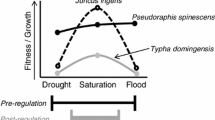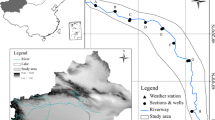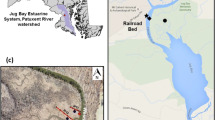Abstract
Maintaining moderate levels of aquatic plant cover in agricultural reservoirs is an important issue because aquatic plant development is closely related to diverse ecosystem functions, including the regulation of the microconditions of the air–water environment, the production of food sources, and the structuring of physical habitats. We analyzed annual changes in aquatic plant cover in the Junam reservoirs using remote sensing images and field-survey data. We established a time series of aquatic plant cover using satellite images, aerial photography, and field-survey data from 1997 to 2016. We assessed the relationship between aquatic plant cover and reservoir environmental conditions. No monotonic trend in aquatic plant cover was observed during the 20-year study period. However, we found that the total aquatic plant cover was influenced by a complex combination of meteorological (winter temperature and wind speed), hydrological (water level), and physicochemical (conductivity, N:P ratio) factors for the reservoir. We further suggest a collective management scheme focused on nutrient and water-level conditions to control the overgrowth of aquatic plants in agricultural reservoirs.





Similar content being viewed by others
References
Akhurst DJ, Jones GB, Clark M, Reichelt-Brushett A (2017) Effects of fish and macrophytes on phytoplankton and zooplankton community structure in a subtropical freshwater reservoir. Limnologica 62:5–18
Asaeda T, Van Bon T (1997) Modeling the effects of macrophytes on algal blooming in eutrophic shallow lakes. Ecol Model 104:261–287
Bini LM, Thomaz SM, Carvalho P (2010) Limnological effects of Egeria najas Planchon (Hydrocharitaceae) in the arms of Itaipu Reservoir (Brazil, Paraguay). Limnology 11:39–47
Carlson RE (1977) A trophic state index for lakes. Limnol Oceanogr 22:361–369
de Tezanos Pinto P, O’Farrell I (2014) Regime shifts between free-floating plants and phytoplankton: a review. Hydrobiologia 740:13–24
Finlay K, Vogt RJ (2016) An ecosystem management framework to maintain water quality in a macrophyte-dominated, productive, shallow reservoir. Hydrobiologia 776:111–123
Gao B (1996) NDWI—a normalized difference water index for remote sensing of vegetation liquid water from space. Remote Sens Environ 58:257–266
Grzybkowska M, Kucharski L, Dukowska M et al (2017) Submersed aquatic macrophytes and associated fauna as an effect of dam operation on a large lowland river. Ecol Eng 99:256–264
Gubiani ÉA, Thomaz SM, Bini LM, Piana PA (2017) Metapopulation models predict the temporal response of two macrophytes to drought in a subtropical water reservoir. Ecol Eng 100:1–7
Henderson JE, Kirk JP, Lamprecht SD, Hayes WE (2003) Economic impacts of aquatic vegetation to angling in two South Carolina reservoirs. J Aquat Plant Manage 41:53–52
Hu H, Hong Y (2008) Algal-bloom control by allelopathy of aquatic macrophytes—a review. Front Environ Sci Eng China 2:421–438
Janssen ABG, Teurlincx S, An S et al (2014) Alternative stable states in large shallow lakes? J Gt Lakes Res 40:813–826
Kato Y, Nishihiro J, Yoshida T (2016) Floating-leaved macrophyte (Trapa japonica) drastically changes seasonal dynamics of a temperate lake ecosystem. Ecol Res 31:695–707
Kawatsu M, Morimoto G, Kagami M (2015) Seasonal changes in the water bird community in Lake Inba: influence of floating-leaved macrophytes on habitat selection. Aqua Bot 126:32–37
Keitel J, Zak D, Hupfer M (2016) Water level fluctuations in a tropical reservoir: the impact of sediment drying, aquatic macrophyte dieback, and oxygen availability on phosphorus mobilization. Environ Sci Pollut Res 23:6883–6894
Khanday SA, Yousuf AR, Reshi ZA et al (2017) Management of Nymphoides peltatum using water level fluctuations in freshwater lakes of Kashmir Himalaya. Limnology 18:219–231
Kim J-Y, Kim D-Y, Oh J-H (2014) Projected changes in wind speed over the Republic of Korea under A1B climate change scenario. Int J Climatol 34:1346–1356
Kim J, Sang W, Shin P et al (2015) Evaluation of regional climate scenario data for impact assessment of climate change on rice productivity in Korea. J Crop Sci Biotechnol 18:257–264
Kim JY, Im R-Y, Do Y et al (2016) Above-ground biomass estimation of tuberous bulrush (Bolboschoenus planiculmis) in mudflats using remotely sensed multispectral image. Ocean Sci J 51:151–158
Kim JY, Kim GY, Do Y et al (2018) Relative importance of hydrological variables in predicting the habitat suitability of Euryale ferox Salisb. J Plant Ecol 11:169–179
KMA (Korea Meteorological Administration) (2017) Homepage. https://web.kma.go.kr/eng/. Accessed 8 March 2017
Kunii H (1988) Seasonal growth and biomass of Trapa japonica Flerov in Ojaga-Ike Pond, Chiba, Japan. Ecol Res 3:305–318
Lee K-S, Cho M-G, Moon H-S, Jeon K-S (2013) The list of vascular plants at Junam wetland in Changwon City (in Korean). Kor J Agr Forest Meteorol 15:67–75
Lehner B, Liermann CR, Revenga C et al (2011) High-resolution mapping of the world’s reservoirs and dams for sustainable river-flow management. Front Ecol Environ 9:494–502
McFeeters SK (1996) The use of the normalized difference water index (NDWI) in the delineation of open water features. Int J Remote Sens 17:1425–1432
Nemoto F, Fukuhara H (2012) The antagonistic relationship between chlorophyll a concentrations and the growth areas of Trapa during summer in a shallow eutrophic lake. Limnology 13:289–299
NIBR (2014) 2014—Winter waterbird census of Korea (in Korean). National Institute of Biological Resources, Incheon
Nohara S, Tsuchiya T (1990) Effects of water level fluctuation on the growth of Nelumbo nucifera Gaertn. in Lake Kasumigaura Japan. Ecol Res 5:237–252
Paerl HW, Gardner WS, Havens KE et al (2016) Mitigating cyanobacterial harmful algal blooms in aquatic ecosystems impacted by climate change and anthropogenic nutrients. Harmful Algae 54:213–222
Paillisson J-M, Marion L (2006) Can small water level fluctuations affect the biomass of Nymphaea alba in large lakes? Aquat Bot 84(3):259–266
Paolini L, Grings F, Sobrino JA et al (2006) Radiometric correction effects in Landsat multi-date/multi-sensor change detection studies. Int J Remote Sens 27:685–704
Patel S (2012) Threats, management and envisaged utilizations of aquatic weed Eichhornia crassipes: an overview. Rev Environ Sci Biotechnol 11:249–259
Peng C, Zhang L, Qin H, Li D (2014) Revegetation in the water level fluctuation zone of a reservoir: an ideal measure to reduce the input of nutrients and sediment. Ecol Eng 71:574–577
Phartyal SS, Rosbakh S, Poschlod P (2018) Seed germination ecology in Trapa natans L., a widely distributed freshwater macrophyte. Aqua Bot 147:18–23. https://doi.org/10.1016/j.aquabot.2018.02.001
Rast W, Straškraba M (2000) Lakes and reservoirs: similarities, differences and importance. United Nations Environment Programme—International Environmental Technology Centre, Osaka.
RAWRIS (2017) Rural agricultural water resource information system (in Korean). https://rawris.ekr.or.kr/facilities_present.do Accessed 8 March 2017
Reshef DN, Reshef YA, Finucane HK et al (2011) Detecting novel associations in large data sets. Science 334:1518–1524
Scheffer M, van Nes EH (2007) Shallow lakes theory revisited: various alternative regimes driven by climate, nutrients, depth and lake size. Hydrobiologia 584:455–466
Scheffer M, Szabó S, Gragnani A et al (2003) Floating plant dominance as a stable state. PNAS 100:4040–4045
Walker PD, Wijnhoven S, van der Velde G (2013) Macrophyte presence and growth form influence macroinvertebrate community structure. Aqua Bot 104:80–87
WIS (2017) Water information system (in Korean). http://water.nier.go.kr/front_new/waterMeasurement/selectWater.do. Accessed 8 March 2017
Zargar M, Samani HMV, Haghighi A (2016) Optimization of gated spillways operation for flood risk management in multi-reservoir systems. Nat Hazards 82:299–320
Zhang C, Liu H, Gao X, Zhang H (2016) Modeling nutrients, oxygen and critical phosphorus loading in a shallow reservoir in China with a coupled water quality—macrophytes model. Ecol Ind 66:212–219
Zohary T, Ostrovsky I (2011) Ecological impacts of excessive water level fluctuations in stratified freshwater lakes. Inland Waters 1:47–59
Acknowledgements
This research was supported by Basic Science Research Program through the National Research Foundation of Korea (NRF) funded by the Ministry of Education [no. 2016R1A6A3A01009457].
Author information
Authors and Affiliations
Corresponding author
Additional information
Handling Editor: Takehito Yoshida.
Rights and permissions
About this article
Cite this article
Kim, J.Y., Joo, GJ. Combined influence of meteorological, hydrological, and physicochemical factors on macrophyte overgrowth in agricultural reservoirs. Limnology 20, 3–11 (2019). https://doi.org/10.1007/s10201-018-0550-6
Received:
Accepted:
Published:
Issue Date:
DOI: https://doi.org/10.1007/s10201-018-0550-6




